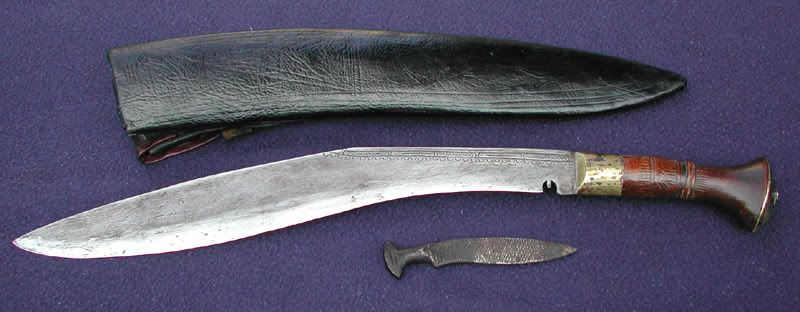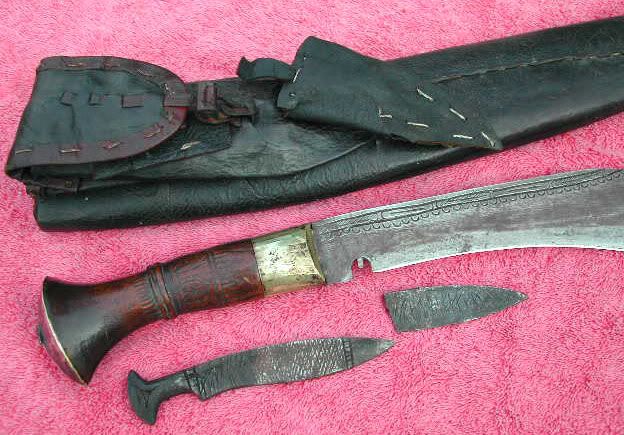
 |
|
|
|
|
#1 |
|
Member
Join Date: Feb 2005
Location: Clearwater, Florida
Posts: 371
|
Not long ago I was able to pick up a little kukri at a ridiculously low price, thanks to a heads up from a fellow forum member (thanks again, Tom!) and the more I look at it the more curious it appears.
I have NO expertese with these at all, probably because of my heavy exposure to the tourist pieces encountered by the hundreds in SE Asia in the late 1960's, a case of familiarity breeding contempt, or at least indifference, thus losing all "exotic" appeal. This little knife, however, has piqued my curiosity all over again and since I know that there are a couple of experts here I thought I'd ask a few questions and hope for some enlightenment. I believe it's what they call the "hanshee" style (?) with the relatively thin, willowy blade as opposed to the heavier stereotype that commonly comes to mind, running 16" OA and with a 12 1/2" blade. The overall feel of the knife and scabbard both, to me, is that it's got some age to it and that it's a user knife all the way, yet there are several points that seem to contradict this, such as no fuller in the blade and an unusual pattern where a fuller would normally be expected. The sheath is a dark brown lightly tooled leather with buttons, the two mini-sheaths or pockets expected for the two side knives (only one is present, thick, completely squared off on the sides..a sharpener or striker?) and a third pocket with a flap that folds over it (for a whetstone?). The handle is plain hardwood with a pattern very much like the one incised in the blade spine about midway in a band around the hilt, with no exposed tang showing at all and likewise, with no metal "buttplate" as I've seen on many. There doesn't appear to have ever been a "toe" on the scabbard, with a small portion rounded and worn away, aparently from normal use. The blade is in fair shape with moderate pitting at the tip and a couple of small nicks, but I get the impression that the knife was well used but also very well cared for during and after its normal "life". I'm sure that I skipped over may pertinent points, but, as I said, I've never paid particualr attention to kukris in general...what really suprises me is that I'm usually attracted to large, cleaver-type knives and swords and this kukri seems to be smaller and lighter than many to most yet feels perfect in the hand, as if it's trying to "talk to me" if you know what I mean (and NO, not verbally!! **grin**) Anything that you can tell me about this little piece would be truly appreciated. Mike |
|
|

|
|
|
#2 |
|
Member
Join Date: Dec 2004
Location: What is still UK
Posts: 5,807
|
Hi Mike .The kukri you have is I think pre ww2 and from Nepal.Here are two ,one pre war from Nepal and the other with the straps Indian for ww2 use,Tim
|
|
|

|
|
|
#3 |
|
Member
Join Date: Dec 2004
Location: Houston, TX, USA
Posts: 1,254
|
 The treatment of the grooveless area near the spine may be similar, but I don't see what else? THe blade shape is quite different, as is the bolster, which on Conogre's appears to be made of iron(?) and to serve as a functional ferule. The treatment of the grooveless area near the spine may be similar, but I don't see what else? THe blade shape is quite different, as is the bolster, which on Conogre's appears to be made of iron(?) and to serve as a functional ferule.The small "blade" sounds like a fire striker. Interestingly, what I've heard is tjhat the flat pointy knife-blade-shaped pockets twice as wide as the two normal side-blade pockets, on the backs of some sheaths is a wallet for spices, drugs, etc. Tobacco is usually cited. The decorative lines, which may be referential to panel welded steel, appear to be chiseled, rather than etched, etc., and look to have been thru at least one fairly serious after market polishing, or perhaps a series of routine ones. BTW, gald you like it 
|
|
|

|
|
|
#4 |
|
Member
Join Date: Dec 2004
Location: What is still UK
Posts: 5,807
|
Hello Tom, it is more that the leather work is the same.The older Nepal leather seems thinner and in a way harder and has the same tooling.The Indian one has a thicker more soft leather.This example has got damp in the past possibly in the Burma campain.Tim
|
|
|

|
|
|
#5 |
|
Member
Join Date: Dec 2004
Location: What is still UK
Posts: 5,807
|
P.S. the decoration is inlaid brass and the pocket at the back does hold a flap for tinder or drugs or what you fancy.It is late now I will post pics tomorrow.Also the ring in the handle.Tim
|
|
|

|
|
|
#6 |
|
Member
Join Date: Feb 2005
Location: Clearwater, Florida
Posts: 371
|
Thanks for all of the information so far....the design in the blade near the spine is indeed chiseled and from the looks of it was very clean and deep originally, making me suspect that it may be much older than I at first thought as it takes a LOT of cleaning to wear away that much steel.
It's amazing how one piece can sometimes re-open old eyes and make one (me, in this case) re-assess an entire class of weapons with much more respect. Over the years the kukri is one of the few bladed weapons that comes to mind with nearly as much lore and fable surrounding it as the Moro Sanduko Barung. Mike |
|
|

|
|
|
#7 |
|
Member
Join Date: Dec 2004
Location: Kernersville, NC, USA
Posts: 793
|
Nice khukuri Mike. Hopefully John Powell will be along soon, as he is the premier khuk expert. It looks similar to the sirupati, a lighter khukuri. I have one similar to yours. Inside the pocket with a flap may be a removeable pouch. It was used to carry tinder and a flint for starting a fire. The blunt chakma was used to steel the edge of the blade, and also for striking the flint to make a fire. At least this is my understanding.
For some interesting reading, check out the khukuri faq here http://www.himalayan-imports.com/faq/ Here's a pic of mine. It has an interesting all iron chakma.   Edited: I don't think it's a hanshee, as those are most characterised by more curve, and a long narrow curved handle, like the top two here:  (picture belongs to John Powell) (picture belongs to John Powell)Steve |
|
|

|
|
|
#8 |
|
Member
Join Date: Dec 2004
Location: Houston, TX, USA
Posts: 1,254
|
bang! There it is. Note the ferule, too.
The thing about using the chakma to burnish the edge of the sword is that it would have to be at least as hard as that edge, and preferably considerably harder; but is this the case? Kukuris I've sharpened were edge-hardened, and sometimes with a pretty darn hard edge. In any event, I really like the one-piece one; neat 
|
|
|

|
|
|
#9 |
|
Member
Join Date: Dec 2004
Location: What is still UK
Posts: 5,807
|
More pictures.The flash tends to show things so clean.The Nepalese? one is much finer,
|
|
|

|
|
|
#10 |
|
Member
Join Date: Feb 2005
Location: Clearwater, Florida
Posts: 371
|
Thanks again all, and I think you're probably correct about the sirupati vs hanshee as well, Steve.
The only bad thing about the search engine is that you frequently have to remember the terms to bring up much about it...thus I've started making sure the titles in any posts I make will come up under a basic search **so much for cute or witty!**. I'll definitely check out that thread as well as several others, and thanks there as well.....I presume the untanged and peened hilt is just local custom or a particular smith (term?) as I understand that they were and still are made at a village level over a wide range. The little "knife" that's present with mine is VERY hard, Tom, and definitely never intended to be sharpened so is definitely serviceable as a striker and possibly as a honer as well. Those are some beautiful pieces that you have there....I've got to do a better search in the archives as I remember some excellent and rather extensive photos several years ago, both on kukris and koras. Mike |
|
|

|
|
|
#11 |
|
Member
Join Date: Feb 2005
Location: Clearwater, Florida
Posts: 371
|
Since the terms "falcata" and "kopis" so commonly come up in connection with the kukri, here's a couple of photos of contemporary weapons grade reproductions of each.
As you can see the smiths have taken liberties with both, the falcata being scabbarded very much like a kukri and the kopis being made with a steel blade, where so far as I know, all of the originals were bronze and, unless I'm mistaken, Egyptian? Both were hand forged in India. Mike |
|
|

|
|
|
#12 |
|
Member
Join Date: Dec 2004
Location: Houston, TX, USA
Posts: 1,254
|
Actually, aside from the side knife, which I don't know about, that sheath is a pretty good looking repro of ancient Itallian sheaths.
Interesting interpretation of an Egypto/Palestinian kopsh. |
|
|

|
|
|
#13 |
|
Member
Join Date: Feb 2005
Location: Clearwater, Florida
Posts: 371
|
The kopis, I believe, is based primarily upon ancient artwork, with very few surviving into the present, if any at all.
In this particular piece, it's so blade heavy that it's almost painful to the wrist to try and wield it with one hand, much like most of the "ceremonial kukris" that I've seen, to the point that I've only encountered one with a hilt large enough for a two-handed grip and yet still thin and balanced enough to be utilized with one hand if need be. This particular kopis, to me, is only practical if it's primarily wielded much like a great sword, with one hand on the hilt and the other on the ricasso, in which case it has some very real and interesting possibilities but ends up being used very differently than you would expect out of necessity. It's my understanding that an original out of bronze may have been even heavier, thus would likely have been deeply fullered, the reason for the attached side pieces, purely ornamental on one made of steel and serving no purpose except to add weight. The falcata, on the other hand, has a really good "feel" to it and I can see where it may have given the Romans some real pause when wielded by an enemy, primarily in the hands of the Spanish, if I understand correctly. Mike |
|
|

|
 |
|
|